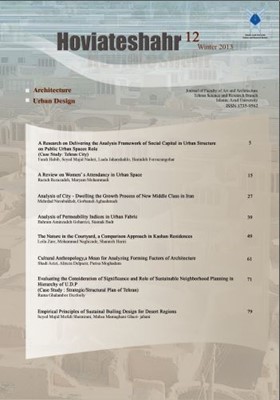Analysis of City-Dwelling the Growth Process of New Middle Class in Iran
Subject Areas : architectureMehrdad Navabakhsh 1 , Gorbanali Aghaahmady 2
1 - Professor, IAU, Sciences and Research Branch, Tehran, Iran.
2 - graduate of sociology, IAU, Sciences and Research Branch Tehran.
Keywords:
Abstract :
Some factors such as education, profession, social status and income determine the structure of the new middle class in today’s Iranian society. The present article attempts to analyze the relationship between city-dwelling and development of the new middle class in Iran. The urban environment has paved the way for inclination to stratification and development of a hierarchy based on criteria that are related to the social classes. The development of distribution of social work and the growth of socio-economic organizations and institutions, complex network of the spaces and social relations and the urbanization system and its rapid pace in developing countries has brought about vast influx to cities and the emergence of service, bureaucratic, and technocratic sectors, as well. The present research has been carried out taking into consideration the viewpoints of Ph.D. and M.A. students of Islamic Azad University, Sciences and Research Branch in Tehran. The present study has employed library research methods in order to identify the research variables. To produce a researcher-made questionnaire, expert opinion was obtained through Delphi method. The population of the study consists of 16179 people in 1388-89 academic year. Using Cochran formula, 443 people were chosen as the sample by means of simple random sampling technique. The study has been done using questionnaire and is based on the fuzzy logic, the Cronbach’s Alpha Index of which is 0.87. The research findings indicate that city-dwelling has paved the way for the growth of the new middle class in Iran through need for development of specialists and skill-owners, technological services, commercial and industrial capitalization, politico-urban institutions and educational systems. Therefore, it can be concluded that economic, social and cultural atmosphere has had an influential role on the development of the new middle class through attraction of population and through development of employment and need for specialized training. The findings of this article illustrate that urbanization provides an appropriate ground for the growth and development of the new middle class through creation of appropriate space for the development of specialized and service activities, creation of appropriate and inappropriate conditions in industrial and commercial investment, the transition of social relations from traditional to modern, and the development of higher education system. Furthermore, the findings indicate that the development of urban services, having the highest rate and ration, has the most important role in the development and maintenance of the new middle class (1.021). The second most important issue is the specialization of affairs in city (.913) and the last is the overall structure of the city (.913). The development of social urbanization has brought about a change in social hierarchies and people’s lifestyle. Training the individuals in higher education and their employment in bureaucratic bodies causes structural renovation of the society. In addition, the findings of the present research are in line with Fialkov’s view that dividing social work and urban techniques along with the activity of craftsmen and bourgeois pave the way for commerce and exchange because exchange with craftsmen gives birth to a new class.
_||_

